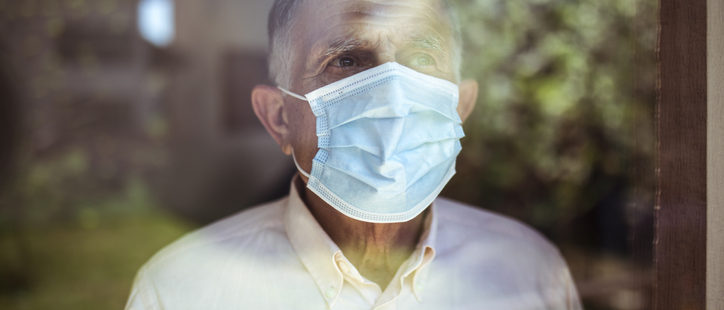This year, loneliness has achieved a new intensity for too many older people. Connection has never been more important – particularly for those in care homes and living with dementia. We explore the toll of people in care homes, isolated from their friends and family.
Living with dementia
Back in March 2020, researchers at the Massachusetts Institute of Technology (MIT) published a paper which showed that loneliness and hunger share signals deep in an area of the brain that controls our impulses for both reward and incentive.
This built on the 2015 work from Julianne Holt-Lunstad, professor of psychology and neuroscience at Brigham Young University, supporting the theory that meaningful emotional connections in our lives are as essential to our wellbeing as our physical need to eat.
Tender physical and emotional contact lies at heart of the human experience. Without these we begin to die. This includes people living with dementia. Around 70 per cent of residents in care homes in England have a dementia diagnosis, with Alzheimer’s being the most common type.
In June 2020, The Guardian reported that “a survey of 128 care homes by the Alzheimer’s Society revealed that 79 per cent report that lack of social contact is causing a deterioration in the health and wellbeing of their residents with dementia.”
Earlier this year Music for Dementia published my blog in which I’d written:
“Those living with dementia are among the most helpless. Connection and communication with the wider world gradually become more and more difficult. With it comes the deepest of loneliness, the loss of meaning, the loss of self, the end of memory. Being afraid is one thing, being unable to articulate this or having no one to share your fears with, is a terror far worse.“
We are all aware of the thousands who tragically lost their lives by contracting COVID-19 and dying in a care home – but how many have died because of social isolation? Or loneliness? And how many, unaware of what was happening, sensed rejection and simply lost the will to live?
Connecting in care homes through Covid
While staff in care homes have been tirelessly doing their very best to look after their residents, under the harshest of circumstances, family and close friend carers will always remain integral members of the residents’ care and support network.
They provide psychological stimulation, and frequently deliver personal care. They are often more attuned to changes in mood and general wellbeing and will be the first to identify when something isn’t right. They also act as advocates, as voice and memory, and help keep residents connected to the world.
“The blanket-lockdown of care homes has meant that voices can only be heard through open windows and shared through social media.”
But many people have no one at all, they are ageing without children and lack close friends. For them, support comes from social workers and specialist charities, but during the pandemic this contact has been limited or non-existent. The blanket-lockdown of care homes has meant that voices can only be heard through open windows and shared through social media.
An early casualty to the virus was visits to care homes by family, close friends and advocates. Recognising the importance of these early-on, some homes sought to adapt their facilities to accommodate face-to-face ‘garden visits’. But these have been time-limited, chaperoned by staff with no privacy. Others have received ‘window visits’ but many homes have remained closed since February or March to outsiders.
Connection is a human right
Gradually the pressure is increasing against such establishments and government policy. Some care homes are recommencing indoor visits – with one designated visitor. Earlier this month, amid a mounting campaign led on behalf of residents’ families by charities including Alzheimer’s Society, AgeUK, the Relatives and Residents Association, John’s Campaign, a dementia action group, applied for a judicial review on the government’s Care Home Visiting Guidance.
At the heart of the John’s Campaign case is the belief that the carers who are family and close friends should be regarded as key workers and are not an optional extra in care home residents’ lives. Connection is a human right and it is being denied through misguided policy.
However, the Government points out that many homes are allowing limited, appointment-only visits – with no physical contact – and that its priority must be to prevent COVID-19 infections, particularly given the upward spike in recorded diagnoses.
A clinical dementia specialist commented on what he had witnessed resulting from the current policy: “Inanition … means suffering malnourishment and starving to death. It means a drifting departure from life. Depression, sadness, loneliness, are brought about by a lack of human contact, all engagement with others withdrawn from them.”
Understanding loneliness
Solitary confinement is the most severe punishment for prisoners in our country, how is it that we currently allow it to be inflicted upon our older citizens, some of the most vulnerable, in our care homes?
Life in care homes can be improved with a deeper understanding of loneliness. This year loneliness has achieved a new and killing intensity for so many older people. But immediately, at the very least, visiting guidelines must be reviewed. Life in a care home with a dementia diagnosis, often accompanied by a sensory or physical disability, must be one of the most disconnected scenarios we could ever face. Let’s not continue to fail in our human obligations. This needs to be sorted, and we have a duty to sort it now.





No comments on this article yet. Please feel free to submit a comment below.
By submitting a comment you grant Campaign to End Loneliness a perpetual license to reproduce your words and name/web site in attribution. Inappropriate and irrelevant comments will be removed at an admin's discretion. Your email is used for verification purposes only, it will never be shared.